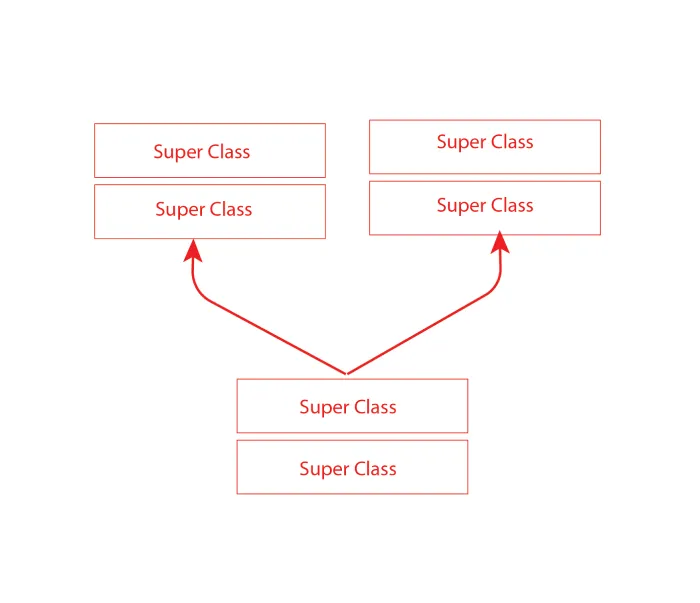Inheritance, a fundamental concept in Object-Oriented Programming (OOP), is the process of inheriting all the properties from another class or superclass. Multiple Inheritance, where we inherit properties from multiple classes, has practical applications in Java programming, making it a concept worth mastering. While Java does not support multiple Inheritance, we can achieve it by using interfaces (instead of classes).
What is Multiple Inheritance?
Multiple inheritance is the process where our subclass inherits more than one superclass. Unlike some other programming languages, like C++, Java does not support multiple inheritance of classes. This means Java cannot inherit multiple superclasses. Java has interfaces.


POSTGRADUATE PROGRAM IN
Multi Cloud Architecture & DevOps
Master cloud architecture, DevOps practices, and automation to build scalable, resilient systems.
Example of Multiple Inheritance in Java
There must be a reason why Java does not support multiple inheritance. Before talking about why. Let’s implement Inheritance in Java.
- The below program has three classes: A, B, and C
- There is one method in classes A and B, which is addition().
- Class c inherits both superclasses using the extends keyword in java
- Main class, we created an object of class C with the name obj itself.
Program
class A{
void addition(int a, int b){
System.out.println("Output = "+(a+b)) ;
}
}
class B {
void addition(int a, int b){
System.out.println("Output = "+(a+b)) ;
}
}
class C extends A,B{
}
public class Example {
public static void main(String args[]){
C ob = new C() ;
ob.addition(20, 30);
}
}
Output
Example.java:15: error: '{' expected
class C extends A, B{
^
1 error
This example will give you an error. Because the compiler is confused about whether to call the addition() from class A or class B
Java interfaces
Java interfaces are used to achieve abstraction, which is one of the principles in Object-Oriented Programming. The Java interface method does not have a Java body. It is also used to implement Multiple Interfaces in the Java language. In other words, interfaces are the methods and variables. They cannot have a method definition or body.
Syntax of Java Interfaces.
interface {
// declare constant fields
// declare methods that abstract
// by default.
}
Syntax of implementing multiple interfaces
class MyClass implements Interface1, Interface2, Interface3 {
// class body
}
Why is Multiple Inheritance Not Supported in Java?
In Java, Multiple Inheritance is not supported by default due to several ambiguity issues. Let’s find out “why this happened with Java”.
- Diamond Problem: One of the well-known issues in Multiple Inheritance is the diamond problem. This problem occurs when a class inherits from two classes that have a common method. If both parent classes have the same method with the same name and the same parameters. Then the java interpreter can’t determine which method to call in the child class.
- Complexity: Multiple Inheritance creates more complex problems and hierarchies, making it harder to understand and maintain code. Java focuses on keeping the language simple and easy to learn, so it does not include features like multiple inheritances that can increase complexity.
- Ambiguity: Allowing multiple inheritance can lead to ambiguity in method resolution. If a subclass inherits methods from two superclasses with the same parameter but different implementations, it is unclear if implementation occurs. This ambiguity can cause errors and make code hard to reason about.

82.9%
of professionals don't believe their degree can help them get ahead at work.
An Alternative to Multiple Inheritance in Java
So, we know that Java programming language does not support Multiple Inheritance in Java. Let’s find an Alternative Approach to this approach.
We can use an interface in Java to implement Multiple Inheritance. A Java Interface is a blueprint of a class that contains abstract methods.
The following program demonstrates the Multiple Inheritance in Java using the interfaces.
- In the code below, we have declared two methods, which is addition().
- The interfaces First and Second define both methods, addition() and addition2().
Program
interface A
{
public abstract void addition(int a, int b);
}
interface B
{
public abstract void addition2(int x, int y);
}
class C implements A,B
{
public void addition(int a, int b)
{
System.out.println("Addition = "+(a+b)) ;
}
public void addition2(int a,int b)
{
System.out.println("Addition = "+(a+b)
);
}
}
public class Main
{
public static void main(String[] args)
{
C obj = new C();
obj.addition(30,40);
obj.addition2(50,70);
}
}
Output
Addition = 70
Addition = 120
By seeing the previous program, we can say that in the Java programming language. We can implement two or more interfaces in the same subclass or child class. Which clearly supports It as an alternative approach to multiple Inheritance in Java language.
Let’s create another example for clarity where two interfaces contain the same method with the same parameters.
The following program has two interfaces, A and interface B, along with an implementation of class C and Main class and interface A and interface B contain the same method, which is addition()
Program
interface A
{
public void addition(int num1);
}
interface B
{
public void addition(int num1);
}
class C implements A, B
{
public void addition(int num1)
{
System.out.println("Output = "+num1);
}
}
public class Main
{
public static void main(String[] args)
{
C obj = new C();
obj.addition(125);
}
}
Output
Output = 125
Conclusion
Java does not directly support multiple Inheritance of classes. However, Java developers can achieve the same thing using the Java language’s interfaces. This allows for achieving some level of code reuse and polymorphism without introducing complexity in the source code. This approach avoids conflicts and keeps code organised and manageable.
Why does Java not support multiple Inheritance of Classes?
How can I achieve multiple inheritance in Java?
What are the drawbacks of multiple inheritance of classes?
What is meant by multiple inheritance?
How many types of inheritance are there in the Java language?
Updated on January 15, 2025
